Vintage Treasures: The Best Science Fiction of the Year 12, edited by Terry Carr
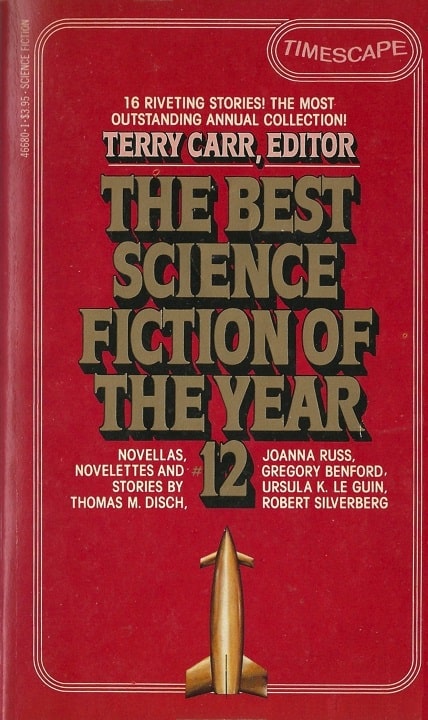 |
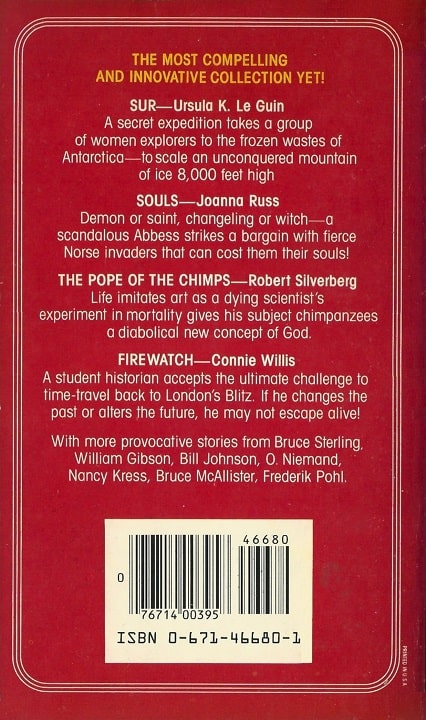 |
The Best Science Fiction of the Year 12 (Timescape/Pocket Books, July 1983)
I recently found a copy of Terry Carr’s 1983 anthology The Best Science Fiction of the Year 12 in a paperback collection I bought on eBay, and I was astonished at just how many great tales it contained.
There’s Connie Willis’s Hugo & Nebula Award winner “Firewatch,” the story of a time-traveling history student doing research during the London Blitz who discovers much more than he bargained for; Joanna Russ’s famous novella “Souls,” a Hugo award-winner in which a resourceful Abbess faces off against invading Vikings; Bruce Sterling’s first short story sale, the Shaper/Mechanist novelette “Swarm;” William Gibson’s early cyberpunk classic (and Nebula nominee) “Burning Chrome;” and Robert Silverberg’s Nebula Award nominee “The Pope of the Chimps,” in which a group of chimpanzees taught sign language develop a religion centered around humans.
There’s even a fine tale by my friend Bill Johnson, whom I worked with for years at Motorola in the 90s, “Meet Me at Apogee.”
[Click the thumbnails for Year’s Best Images.]
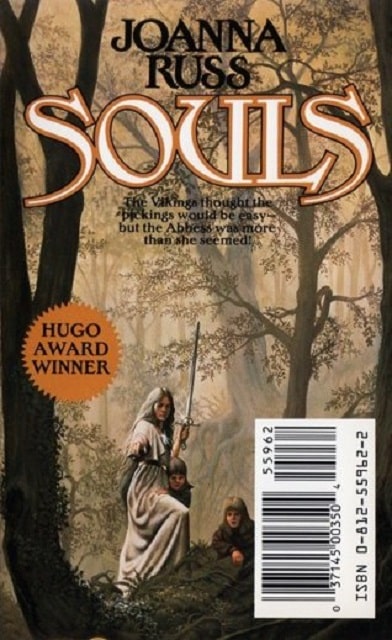 |
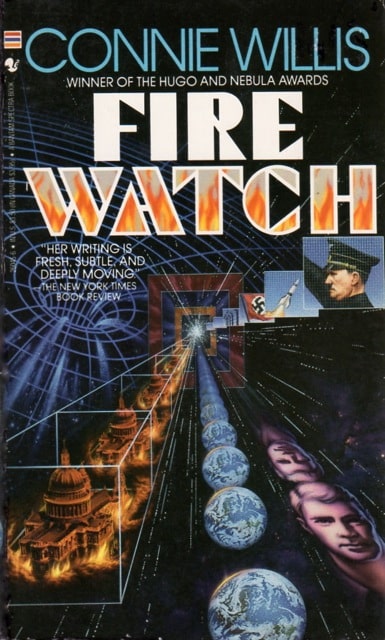 |
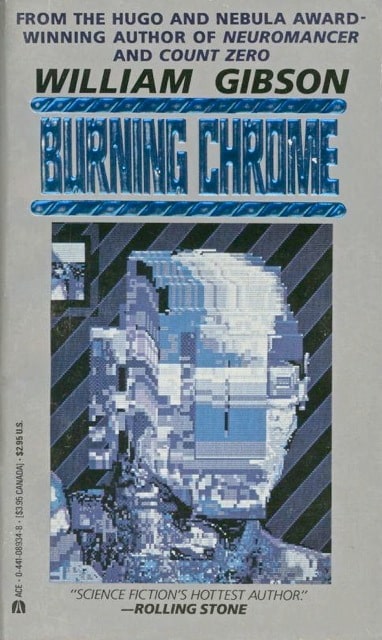 |
A few of the stories reprinted from Best Science Fiction of the Year 12: Joanna Russ’ Tor Double #11: Souls (1989);
Connie Willis’ 1986 collection Fire Watch (Bantam); and William Gibson’s first collection Burning Chrome (Ace, 1987)
It’s been decades since I’ve read some of these stories, and many I’ve never read at all. Finding so many gems together in one place is a very pleasant surprise — and a testament to Carr’s impeccable taste, which seems more and more impressive as the years go by.
Many of these tales generate lively discussion today. Here’s the SF Mistressworks blog on Souls:
Number 11 in the {Tor Double] series was ‘Houston, Houston, Do You Read?’ by James Tiptree Jr… back-to-back with ‘Souls’ by Joanna Russ, which first appeared in F&SF in 1982. Both novellas won the Hugo Award in their respective years. The Tiptree also won the Nebula Award. The Russ was shortlisted but lost to John Kessel’s ‘Another Orphan’…
When a Viking longboat draws up on the shore by the abbey, Abbess Radegunde goes down to the beach to parley with them. Everyone knows what their fate will be – the Vikings are there to rape and pillage. But Radegunde persuades them otherwise. She freely gives up the riches of the abbey in return for the safety of her people. She claims knowledge of some members of the Viking band – through a cousin met in Rome – and it all seems a little convenient. After a little applied psychology, she extracts a promise from the Viking leader, Thorvald. However, during the Vikings’ walk through the abbey’s courtyard, someone panics and it all turns violent. Thorvald manages to re-assert order, but the promise he made is void. At which point, Radegunde… changes. She becomes a much harder and callous person, very different in personality, and seems to “take control” of Thorvald. The narrator, a young boy called Radulphus, is convinced she has become a demon…
Tor double #11 presents a pair of strong novellas, though of the two I think I would sooner present ‘Souls’ as a better example of what the genre can do.
Here’s the Classics of Science Fiction blog on Bruce Sterling’s “Swarm,” in a post from this past January.
What makes “Swarm” good old fashion science fiction? First, it thinks big. Really big. It imagines humanity dividing into two species, the Shapers, who use genetics to become posthuman, and the Mechanists, who use cybernetics as their path to evolving. Making “Swarm” even more exciting is meeting aliens who have chosen a third way, of symbiosis with multiple organisms.
“Swarm” takes place in an alien hive world fashioned out of an asteroid. Two humans, Simon Afriel and Galina Mirny survive there naked, coexisting in the hive ecology of many symbiotic species. Their clothes were consumed right off their bodies by various unintelligent alien critters who serve the hive organism. They eat what the symbiotes regurgitate.
Visually, this reminds me of The Forgotten Planet, by Murray Leinster, Hothouse by Brian Aldiss, and “Surface Tension” by James Blish. It also makes me think of the film Fantastic Voyage but imagining Raquel Welch and Stephen Boyd without suits floating in the inner space of the human body. Simon and Galina float in weightlessness instead of fluids.
William Gibson began publishing short SF in the late 70s; “Burning Chrome” was his first appearance in a Carr Best Science Fiction anthology, the year before his groundbreaking Neuromancer was published as an Ace Special Edition (also edited by Terry Carr). As the story goes, Gibson read an unpublished version of the story at an SF convention in Denver in 1981 to a tiny audience that included Bruce Sterling, whom Gibson said “completely got it.”
It was the first tale to be set in the Sprawl, the urban landscape that appears in much of his famous fiction, and is said to include the first reference to “cyberspace” in print. Bobby Quine, one of the hackers in “Burning Chrome,” is the mentor of Henry Case, the skilled hacker-protagonist of Neuromancer. As Kat Hooper at Goodreads puts it:
“Burning Chrome” is practically a must-read prequel for Gibson’s most famous novel, Neuromancer. It was published in 1982, before Neuromancer, and is Gibson’s first work set in the Sprawl. It introduces the concept of the matrix, Intrusion Countermeasures Electronics (ICE), ICE Breakers, the hackers called console cowboys, and SimStim. You’ll meet The Finn, who’s a mysterious resident of the SPRAWL trilogy, and you’ll see the first usage of the word “cyberspace” in print. If you haven’t read Neuromancer yet, I’d suggest reading this story first.
Here’s that impressive Table of Contents.
Introduction by Terry Carr
“The Pope of the Chimps” by Robert Silverberg (Perpetual Light, 1982) — Nebula Award nominee
“Swarm” by Bruce Sterling (The Magazine of Fantasy & Science Fiction, April 1982) — Hugo, Nebula, Locus nominee
“Souls” by Joanna Russ (The Magazine of Fantasy & Science Fiction, January 1982) – Nebula nominee, Hugo and Locus Award winner
“Burning Chrome” by William Gibson (Omni, July 1982) — Nebula nominee
“Farmer on the Dole” by Frederik Pohl (Omni, October 1982)
“Meet Me at Apogee” by Bill Johnson (Analog Science Fiction/Science Fact, May 1982)
“Sur” by Ursula K. Le Guin (The New Yorker, February 1, 1982) — Hugo nominee, Locus Award winner
“Understanding Human Behavior: A Romance of the Rocky Mountains” by Thomas M. Disch (The Magazine of Fantasy & Science Fiction, February 1982) — Nebula nominee
“Relativistic Effects” by Gregory Benford (Perpetual Light, 1982)
“Firewatch” by Connie Willis (Isaac Asimov’s Wonders of the World, 1982) — Locus nominee, Hugo & Nebula Award winner
“The Wooing of Slowboat Sadie” by George Alec Effinger (The Magazine of Fantasy & Science Fiction, September 1982)
“With the Original Cast” by Nancy Kress (Omni, May 1982)
“When the Fathers Go” by Bruce McAllister (Universe 12, 1982)
The Science Fiction Year (1982), by Charles N. Brown
Recommended Reading – 1982, by Terry Carr
We’ve covered many volumes of Terry’s Carr Year’s Best over the years.
World’s Best Science Fiction 1965 – 1970, edited by Donald A. Wollheim and Terry Carr (1965-1970)
The Best Science Fiction of the Year #3, edited by Terry Carr (1974)
The Best Science Fiction of the Year #4, edited by Terry Carr (1975)
The Best Science Fiction of the Year #5-7, edited by Terry Carr (1976-78)
The Best Science Fiction of the Year #8, edited by Terry Carr (1979)
The Best Science Fiction of the Year #9, edited by Terry Carr (1980)
The Best Science Fiction Novellas of the Year 1, edited by Terry Carr (1979)
Thomas M. Disch on the Best Science Fiction of 1979
A Return to Terry Carr’s Best Science Fiction of the Year
The Best Science Fiction 1974, edited by Lester del Rey, Terry Carr, and Donald Wollheim
The Best Science Fiction of the Year #12 was published by Timescape/Pocket Books in July 1983. It is 359 pages, priced at $3.95.
See all our recent Vintage Treasures here.
I would add a shout-out for “Sur”, which is one of my favorite Le Guin works, a gentle satire of the “heroic”, with an exuberant tale of women inspired to join (and win) the race to the South Pole. Very sur-real and yet oh so humane.
Plus, a delightful vibe of nostalgia as I check the original publications and see 2 entries from Alan Ryan’s anthology of theological sf, Perpetual Light, and 3 entries from Omni magazine, just after Ellen Datlow became Fiction Editor. Gee, I used to read good stuff, back in the day!
Eugene,
I know exactly what you mean! I’ve been dipping into these Terry Car BEST SF volumes for the last few months, and ” a delightful vibe of nostalgia” is the perfect way to describe the experience.
I rarely have time to indulge in nostalgic and re-read the novels that captivated me in those days. But I CAN re-read (for ex) Lucius Shepard’s story “R&R,” and get that same delightful 90s vibe. 🙂
“Swarm” was adapted as one of the episodes of the recent third season of “Love, Death & Robots” on Netflix. It’s an amazing adaptation.
Ah!! I have not yet checked out Tim Miller’s LOVE, DEATH & ROBOTS season three.
Interesting story — Tim read and enjoyed my novel, THE ROBOTS OF GOTHAM, and asked me to submit some story ideas for L,D&R. Only one of the ones I sent seemed to be close to what he was looking for, and even that was probably too long. It’s taught me a very sincere appreciation for the refined art of the SHORT SF tale!
I’ve been collecting this series recently and was just looking at my copy of this book the other day.
Have you dipped into any of them, Keith? I’d love to hand the mic off to someone else if you’d care to share your thoughts.